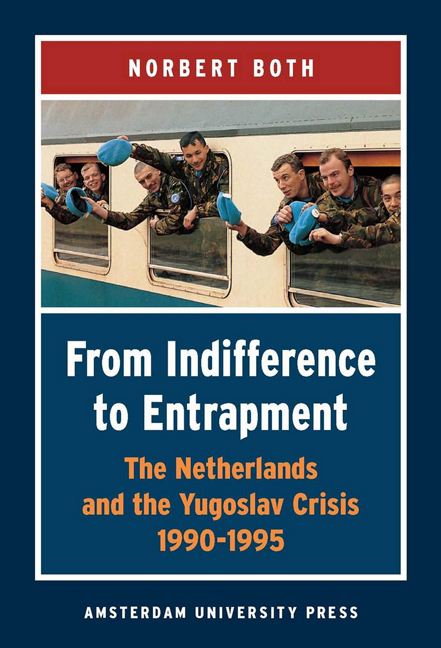Book contents
- Frontmatter
- Dedication
- Contents
- Preface
- Abbreviations
- Chronology
- Introduction
- 1 The Netherlands and its Foreign Policy System
- 2 An Emerging Challenge, July 1990 - June 1991
- 3 From ‘Even-Handedness’ to ‘Selectiveness’, July -December 1991
- 4 Moral and Political Entrapment: The Netherlands and International Peace Plans for Bosnia, 1992-1994
- 5 Military Entrapment: The Commitment to Srebrenica
- Conclusion
- Bibliography
- Index of Names
4 - Moral and Political Entrapment: The Netherlands and International Peace Plans for Bosnia, 1992-1994
Published online by Cambridge University Press: 14 January 2021
- Frontmatter
- Dedication
- Contents
- Preface
- Abbreviations
- Chronology
- Introduction
- 1 The Netherlands and its Foreign Policy System
- 2 An Emerging Challenge, July 1990 - June 1991
- 3 From ‘Even-Handedness’ to ‘Selectiveness’, July -December 1991
- 4 Moral and Political Entrapment: The Netherlands and International Peace Plans for Bosnia, 1992-1994
- 5 Military Entrapment: The Commitment to Srebrenica
- Conclusion
- Bibliography
- Index of Names
Summary
In 1992 Bosnia-Herzegovina became the scene of the next, most violent phase in the Yugoslav crisis. In late March of that year, the Serbian campaign began in earnest. Within the space of little more than two weeks all the cities commanding the roads between Bosnia and Serbia as well as between Bosnia and Serb-held Croatia were taken by Serb forces and emptied of its Bosnian Muslim or Croat population. Subsequently, the roads between these towns were opened up. By May, some six weeks after the start of the campaign, Serb forces controlled some 60 per cent (ultimately 70 per cent) of the territory of Bosnia-Herzegovina, even though Serbs constituted only 31 per cent of the population of Bosnia-Herzegovina. Within the territory taken by Serb forces, thousands of Muslims in particular were murdered and imprisoned, while hundreds of thousands more were driven from their homes in a strategy that became known as ‘ethnic cleansing’. In Eastern Bosnia the towns of Srebrenica, Zepa and Gorazde had somehow withstood the attacks and had been able to organise a Yugoslav-style territorial defence successfully. By the end of the year, the Bosnian Muslim forces from Zepa en Srebrenica, as well as some smaller enclaves to the north of Srebrenica had been able to link up with each other, connecting the isolated enclaves into one swath of territory – having killed hundreds of Serbs in the process. However, isolated from Bosnian Muslim-held central Bosnia, the resistance of these enclaves withered away, so that by March 1993 it looked as if Srebrenica would fall too. This was when the UNPROFOR Commander, French General Philippe Morillon intervened personally and went into the Srebrenica enclave to share the population's plight and stave off further attacks. The UN Security Council subsequently declared Srebrenica a ‘safe area’. A cease-fire agreement was reached between the Bosnian Serb commander, General Ratko Mladic, and the commander of the Bosnian government's forces, General Sefer Halilovic. Canadian peacekeepers were placed inside the ‘safe area’ in order to deter attacks against it. The Canadians were replaced by Dutch peacekeepers in early 1994.
During the first two years of the Bosnian war, from April 1992 until late 1993, the ‘selectiveness’ that had started to emerge during the Dutch term as EC Presidency gradually intensified.
- Type
- Chapter
- Information
- From Indifference to EntrapmentThe Netherlands and the Yugoslav Crisis, 1990–1995, pp. 143 - 180Publisher: Amsterdam University PressPrint publication year: 2012



